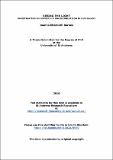Files in this item
Seeing the light : investigating the effects of photoionisation in our galaxy
Item metadata
| dc.contributor.advisor | Wood, Kenny | |
| dc.contributor.author | Barnes, Joanna | |
| dc.coverage.spatial | 188 | en_US |
| dc.date.accessioned | 2016-06-13T15:37:54Z | |
| dc.date.available | 2016-06-13T15:37:54Z | |
| dc.date.issued | 2016-05-25 | |
| dc.identifier | uk.bl.ethos.687030 | |
| dc.identifier.uri | https://hdl.handle.net/10023/8970 | |
| dc.description.abstract | This thesis investigates the impact of photoionisation on gas clouds of various scales in our Galaxy. On kiloparsec scales, the origin of the diffuse ionised gas (DIG) has been studied using Monte Carlo photoionisation simulations in static simulations of the interstellar medium (ISM). Low density pathways through the gas allow photons to propagate, producing the DIG. The emission in this gas indicates that the temperature increases as the density of the gas decreases, suggesting a heating mechanism in the gas that dominates over photoionisation. This has been investigated with the inclusion of an approximation to cosmic ray heating, which is able to reproduce the observed line ratios of [NII]/Hα and [SII]/Hα. It has been suggested that the Hα emission in this gas may not be a result of in situ emission, rather, it results from dust scattering of Hα photons from HII regions. Dust scattering simulations find that 20% of the Hα intensity observed in the diffuse gas is a result of scattering, leaving in situ ionisation as the primary producer of the DIG. The dynamical impact of photoionisation in small-scale gas clouds, as well as larger scale diffuse gas, is now recognised as important in our understanding of star forming regions. A new code has been developed using a combination of hydrodynamical and Monte Carlo photoionisation methods. Tests of the validity of this code are presented, showing that this method accurately reproduces benchmark tests. This method has been used to investigate the lifecycle and x-ray observations of ultra-compact HII (UCHII) regions with the inclusion of stellar wind and photoionisation feedback. These simulations find that x-ray emission is not produced in high enough intensity to be observed until after the UCHII phase, when stellar winds begin to drive the expansion. | en_US |
| dc.language.iso | en | en_US |
| dc.publisher | University of St Andrews | |
| dc.subject | Photoionisation | en_US |
| dc.subject | Galaxies | en_US |
| dc.subject | ISM | en_US |
| dc.subject.lcc | QB790.B2 | |
| dc.subject.lcsh | Interstellar matter | en_US |
| dc.subject.lcsh | Photoionization of gases | en_US |
| dc.subject.lcsh | Stars--Formation | en_US |
| dc.title | Seeing the light : investigating the effects of photoionisation in our galaxy | en_US |
| dc.type | Thesis | en_US |
| dc.contributor.sponsor | Science and Technology Facilities Council (STFC) | en_US |
| dc.type.qualificationlevel | Doctoral | en_US |
| dc.type.qualificationname | PhD Doctor of Philosophy | en_US |
| dc.publisher.institution | The University of St Andrews | en_US |
This item appears in the following Collection(s)
Items in the St Andrews Research Repository are protected by copyright, with all rights reserved, unless otherwise indicated.

